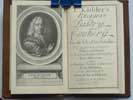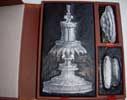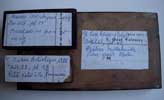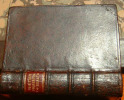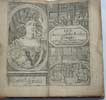W. M.
- The great 17th century Royal classic.
The Queens Closet OPENED.
BEING Incomparable Secrets in Physick, Chyrurgery, Preserving, and Candying, &c. Which were presented to the QUEEN By the most experienc'd Persons of the times, many whereof were had in Esteem when she pleased to descend to private Recreations. The Tenth Edition, Corrected, with many new and large additions; together with Three exact Tables. Vivit post Funera Virtus. LONDON, Printed for E.Blagrave, and are to be sold by the Booksellers of London and Westminster, 1696. Bound with -- A QUEENS Delight:-- OR, The Art of Preserving, Conserving, and Candying. As also, A right Knowledge of making Perfumes, and Distilling the most excellent Waters. LONDON Printed in the Year 1696. Bound with -- The Compleat COOK:-- Expertly Prescribing The most ready Ways, whether Italian, Spanish or French, FOR Dressing of Flesh and Fish, Ordering of Sauces, Or making of PASTRY. LONDON. Printed in the Year 1695.
12mo. 2feps.[1] Frontispiece of Henrietta Maria. Title Page.[1] 2p Preface. 4p Approvers Names. 1-163. 5p 'The Table' - THE 2ND PART; Title Page 'A Queens Delight'.[1] 171-264. 4p The Table. - THE 3RD PART; Title Page 'The Complete Cook'.[1] 271-401. 8p The Table.[1] 2feps. Fully Bound in contemporary dark brown calf with original boards and gilt tooled borders. Re-backed spine with gilt tooling, raised bands, and a red label with gilt lettering. Very clean internally, with minimal ageing to pages. Considering it is over 300 years old, a very scarce item in this fine condition.
-
Henrietta Maria, Born 25 November 1609, was Princess of France and Queen Consort of England, Scotland and Ireland (13 June 1625 – 30 January 1649) through her marriage to Charles I. She was the mother of two kings, Charles II and James II, and was grandmother to Mary II, William III, and Queen Anne.
The often hated catholic wife of King Charles 1 was well acquainted with a number of natural philosophers/scientists, including John Evelyn, Kenelm Digby, the physician Theodore Turquet de Mayerne, the mathematician John Pell and the apothecary John Parkinson. Drawing together the work of these men and other members of the queen’s household, Henrietta Maria’s name is associated with one of the most successful publications of the seventeenth century: ‘The Queens Closet Opened,’ first published in 1655. With various corrections and additions, it went into at least eighteen editions in the seventeenth century alone, and was further reprinted in the 18th century. It was in three parts, ‘The Pearl of Practise’ (remedies), ‘A Queens Delight’ (confectionery), and ‘The Compleat Cook’ (cookery). In the Preface, the presenter, W. M., informed the public that these were Henrietta Maria’s own receipts: Who is W.M.? In her fascinating article online, Jane Archer, of the University of Warwick, puts forward some compelling facts to support the theory that,----- ‘W. M.’ would have been instantly identifiable as Walter Montagu[e] (c.1603-1677), perhaps the closest and most loyal of Henrietta Maria’s ‘late servants’. A Catholic, an exile, a published author, a loyal servant who ‘fell with the Court’, and a secretary ---‘ Jane archer elaborates ‘---The precise facts of Montagu’s life are sketchy, but it is clear that he served Henrietta Maria as secretary and spy, a keeper and discoverer of secrets. The second son of the Earl of Manchester and a protégé of the Duke of Buckingham, Montagu first met Henrietta Maria in 1624, when he was sent on a secret mission to France to prepare the way for marriage negotiations. Following Buckingham’s assassination in 1628, Montagu established himself as a leading member of the Queen’s court at Denmark House. During the 1630s, he influenced the religious, political, cultural and philosophical life of Henrietta Maria’s household. Following his conversion to Catholicism in 1635, Montagu encouraged the Queen to take a more active role in propagating the Catholic faith in England ----‘ (because of this pushing of the Catholic faith, she become a hated figure, and her portrait as frontispiece to the ‘Closet Opened’ was often torn out. This is why many copies now lack the unique engraving) -----‘Montagu spent these years supervising the publication of his writings (some of which had previously circulated in manuscripts) in England. A brief scan of the dates of Montagu’s publications (1648, 1649, 1656 and 1660) reveals that he was in close and frequent contact with London publishers during the period when The Queens Closet Opened was first published.’ Archer further states ---‘ Indeed, if Montagu can be identified with ‘W. M.’, then it is tempting to interpret the publication of The Queens Closet Opened as a continuation of his work as loyal secretary to Henrietta Maria. An important aspect of the work of a secretary. ----‘ Due to failing health Henrietta Maria returned to her native France on the 24th June 1665,
and lived the remainder of her life there. She died on 9th September 1669 at Colombes, near Paris. She was buried in St. Denis with the exception of her heart which was separately interred at Chaillot in a silver casket bearing the inscription;
“Henrietta Maria, Queen of England, France, Scotland and Ireland, daughter of the King of France Henry IV the Victorious, wife of Charles I the Martyr and mother of the restored Charles II”. By any standards; a unique life and a unique book.






|
|

Antiquarian category
ref number:
10920
|






